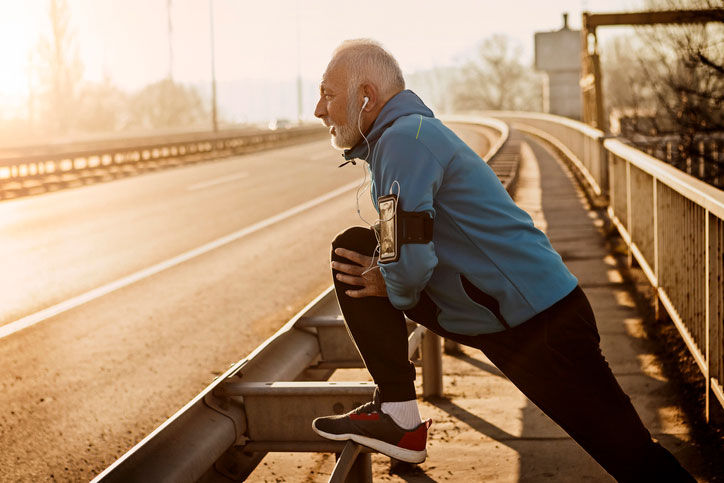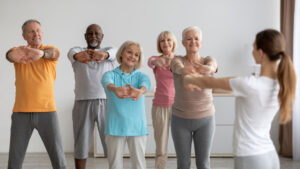 Getting old is, at best, a mixed bag. For every bit of wisdom that comes with age, there’s a new little ache to endure — a joint that creaks when it rains, a muscle that wears out quicker than it used to, or a sharp pain that radiates from somewhere deep within the body.
Getting old is, at best, a mixed bag. For every bit of wisdom that comes with age, there’s a new little ache to endure — a joint that creaks when it rains, a muscle that wears out quicker than it used to, or a sharp pain that radiates from somewhere deep within the body.
For the 77% of adults (as surveyed by AARP) who want to age in place at home instead of in an assisted living community, overcoming these pains and maintaining mobility is of the utmost importance.
“[Aging adults] want to live in their homes as long as they can,” Concordia University, St. Paul Exercise Science Professor Jennifer Myers told us. “They see themselves as somebody who still should be able to climb the stairs and lift dumbbells and come to yoga class.”
But as simple as these goals seem, are they realistic for aging adults? What unique obstacles come with something as broad as maintaining mobility? And how can today’s personal trainers make aging in place accessible to a wider group of people?
In a special interview with PersonalTrainerEdu.org, Professor Myers shed some light on these questions. Guided by her insights and some statistics about the science of aging, personal trainers of all kinds can better understand the needs of an exciting and motivated client base.
The Good News: Adults Can Maintain and Improve Mobility Well Into Their Golden Years
Professor Myers offered that people who want to age in place share a common goal: “to be confident and comfortable with movement.” Remaining in the comfort of one’s own home hinges on the ability to carry out simple daily tasks. Fortunately, studies show that age isn’t always an unconquerable barrier to this feat.
According to a 2018 paper published in the peer-reviewed journal Physiological Reviews, adults at about age 50 can increase their aerobic function, muscle mass, and strength by 30% with proper training. And even though adults older than 50 might not see as many improvements in these areas, the paper posits that they too can maintain mobility through exercise.
So while this means that personal trainers may have to help their clients manage their expectations (and their workout routines), the capacity to maintain and improve mobility could be encouraging to anyone worried about aging in place.
Mobility Training Exercises
Aging in place is quite a unique goal in the wider scope of physical training. There’s no one event to prepare for and no competitors to leave in the dust. Instead, aging adults want to make sure they can simply take care of themselves. While some seniors get assistance from caretakers and family members, even they need to maintain a certain level of mobility.
Doing this requires a diverse exercise routine that could include:
- Aerobic exercises. Walking, biking, and swimming are examples of aerobic exercises. By employing the lungs and heart, these exercises can be key to cardiovascular health and building stamina.
- Anaerobic exercises. Anaerobic exercises use the body’s stored energy sources (like glucose) instead of oxygen. This can help regulate metabolism, build lean muscle, and improve circulation. Anaerobic exercises like pilates and yoga can also increase flexibility and balance.
- Dynamic stretching. Dynamic stretches put muscles, joints, and soft tissues through their full ranges of motion which could help aging adults maintain flexibility. Examples include trunk twists and arm circles.
- Static stretching. As the name suggests, static stretching is the act of stretching a specific muscle group to its furthest limit and holding it there. This can reduce stiffness and the chances of pulling a muscle.
- Myofascial release. In many cases, aging adults or people with specific physical conditions suffer from pain centered around the fascia, connective tissue that holds many parts of the body together. Myofascial release therapy alleviates tension in those areas. Even though people can do myofascial release exercises at home with exercise balls or foam rollers, aging adults may want to leave this kind of therapy to trainers and licensed physical therapists.
Not every type of exercise is appropriate for all aging adults. Trainers may personalize their clients’ routines based on age, ability, and overall health status. While many personal trainers shy away from one-size-fits-all approaches, it’s particularly important when serving older clients who may have chronic health conditions or may just be a little more fragile than the average client.
The Bad News: Many Adults Live Sedentary Lifestyles That Can Make Staying Home Dangerous
Even though the vast majority of adults plan on aging in place, many of them are wholly unprepared to do so. But chronic health conditions aren’t the only factors that could complicate their plans.
 The CDC reports that around 60% of adults don’t get the recommended amount of exercise. 25% don’t exercise at all. Given the drastic changes the body goes through during the aging process, living a sedentary lifestyle could lead to a loss of mobility.
The CDC reports that around 60% of adults don’t get the recommended amount of exercise. 25% don’t exercise at all. Given the drastic changes the body goes through during the aging process, living a sedentary lifestyle could lead to a loss of mobility.
And less mobility doesn’t just mean less freedom. In a review of mobility-based studies published in Frontiers in Physiology, researchers found that seniors with restricted mobility experience more falls and hospitalizations — factors that contribute to increased healthcare costs, higher mortality rates, and a generally lower quality of life.
However, unlike aging itself, these circumstances aren’t necessarily inevitable even for adults with decreased mobility. No matter where they are in their fitness journeys, they can turn to experienced personal trainers and other health professionals for guidance.
Bridging the Gap: How Personal Trainers Can Help People Age in Place
Less active adults may balk at the idea of improving their health later in life because, as Professor Myers told us, “It’s one thing to know that you need to do it, but it’s another thing to say, ‘Where do I start? How do I set some goals?’” When personal trainers take it upon themselves to learn how to better serve specific subsections of the aging population, they can become invaluable parts of seniors’ healthcare teams.
Take, for instance, the case of a person with a heart condition or type 2 diabetes, a condition that affects up to 35 million people by CDC estimates. With their doctor, a personal trainer, and perhaps a nutritionist, this person can develop a holistic mobility training routine that meets all of their specific health needs.
Personal trainers can also be helpful for people who don’t suffer from any one specific disease, but instead feel intimidated by working out. Even though preparing to age in place may seem like a great reason to overcome one’s exercise fears, a study of over 2,000 adults found that lack of support, motivation, time and a fear of injury were some of the most common reasons people avoid exercise. Under the guidance of a personal trainer, these people can feel a little more confident in their quest to live long, healthy lives in their own homes.
The Growing Need for Personal Trainers
 To stay ahead of the curve, Professor Myers likes to stay up-to-date on two things: exercise research and potential opportunities for her students. For personal trainers who want to bring their talents to older clients, she sees quite a wealth of available career paths.
To stay ahead of the curve, Professor Myers likes to stay up-to-date on two things: exercise research and potential opportunities for her students. For personal trainers who want to bring their talents to older clients, she sees quite a wealth of available career paths.
“[Personal trainers] take their baseline knowledge and then apply it to a special population,” she says. “There’s a lot of different ways – and populations – that you can serve.”
Within the aging adult population itself, there are many subgroups a personal trainer can learn about serving:
- Already active adults who need help navigating the aging process.
- Sedentary adults who want to become more active.
- Seniors in nursing homes and assisted living communities.
- Adults with specific chronic health conditions.
- Former athletes with old injuries.
- Aging adults who want to take up new physically-demanding hobbies like jogging, hiking, or cycling.
Considering that America’s senior population is expected to grow to 95 million people by 2060, these groups may need more personal training services in the future. And with more resources like online personal trainer booking apps available, maintaining mobility may become a more accessible goal for seniors everywhere. Because of this, Professor Myers feels optimistic about personal trainers who want to expand their careers.
“I think if someone were really into the entrepreneurial business aspect of things, and they found a niche market,” she says, “the sky would be the limit.”
